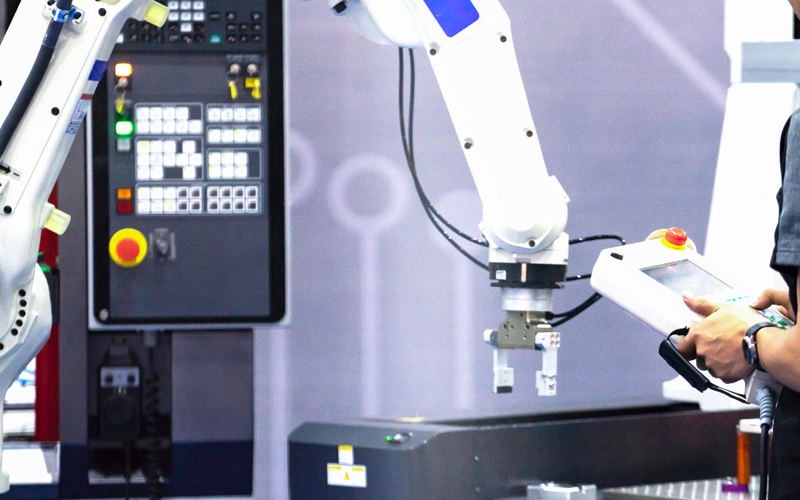The manufacturing industry continuously strives to optimise its efficiency and costs. Global manufacturing industries are likely to face a skilled and unskilled manpower shortage because they are constantly striving to improve efficiency and reduce costs, or due to staff turnover due to various reasons. Manufacturers are increasingly turning to automation for answers to problems such as skills gaps, optimisation of both time and processes, and the all-essential requirement for long-term growth – constant improvement in product quality.
In the manufacturing industry, the application of automation is prominently in the form of hardware addition. This could be in the form of various additions such as devices with vision imaging capabilities, devices that help in transportation, devices that can perform repetitive tasks with precision, and several other such options. The result of such application of automation leads to significant savings in labour costs, consistent product quality, and standardised processes resulting in measurable and predictable levels of efficiency. With such assured advantages, it is not hard to imagine an automation-assisted manufacturing sector becoming the accepted norm. Human workforces working collaboratively with automation is a trend that is here to stay. According to Research and Markets, “the global market for collaborative robots will grow from USD 1.2 billion in 2021 to USD 10.5 billion in 2027, with a CAGR of 43.4%”.
Manufacturing Automation Trends
1. IoT (Internet of Things) is expected to grow bigger
The first devices connected to the internet were computers, and now we have connected appliances, smart televisions, alarm systems, and cameras to name a few. In the manufacturing industry, IoT is one of the hottest trends. Until now, technology has been used primarily for running businesses and managing manufacturing operations, automating processes, and collecting data related to assembly jobs. However, IoT goes well beyond this to the next level of data collection. IoT aids in the collection of data from operations, production, quality, utilisation, consumption, etc. This data is then analysed and the results are used to take decisions that streamline and refine business processes. Using IoT solution platforms, such data can be captured easily and analysed to provide hidden insights into different aspects of manufacturing processes and improve operational efficiency. By providing a digital identity to their physical assets, manufacturing companies are gaining better visibility into their operations and increasing their efficiency.
2. The rise of 3D printing
3D printing may sound like an innovation, but additive manufacturing has been using it for years and the technology has come into more mainstream use of late. The manufacturing industry has been transformed by 3D printing. By building on-demand products, factories can reduce the cost of prototyping new products. In the manufacturing industry, 3D printing is becoming increasingly popular due to its ability to revolutionise the time-consuming and costly process of tooling. Spare parts for mass production of equipment used to take months to produce. It takes only a couple of days to make them using 3D printing.
3. Impact of robotics
Robots and machines have become synonymous with automation, which reduces or replaces work traditionally performed by employees with machines. Automation in the manufacturing industry is not just limited to robotics. Materials handling and pick-and-place tasks can be carried out more efficiently and rapidly with robotics, such as three- and six-axis robotic arms. Robots can be used in a variety of industrial applications to improve high-volume, repeatable processes, such as lifting heavy objects and orienting parts on conveyor belts. Using advanced technology, engineers can program robotics to be more flexible or do the same thing every time.
4. Scaling Artificial Intelligence (AI) in manufacturing operations
Using artificial intelligence to maintain production environments in a smarter way will play a critical role in manufacturing. Manufacturers use predictive solutions to prevent sudden damage to machinery. AI-enabled solutions can predict the failure of equipment before it is damaged. In the same way, artificial intelligence in manufacturing also helps manufacturers deliver faultless products on time. AI tools for manufacturing use machine learning to predict when machinery needs maintenance. Thus, manufacturers can also reduce maintenance costs by using predictive maintenance on devices. Logistics and warehouse management can also be optimised with artificial intelligence tools and apps. AI can be used to analyse everything from production to delivery. As a result, AI in manufacturing impacts product quality and ensures profitability.
What's next?
In spite of all of the challenges that lie ahead, the manufacturing sector is positioned for growth. For manufacturers to survive and thrive, they must adopt specific changes and leverage the right technology.
Manufacturing is experiencing a dynamic wave of automation
Increased productivity, higher sales, employee efficiency, improved work, and streamlined structures are among the intangible benefits of automation.
There have never been such huge opportunities in industries. Through rapid automation, businesses have achieved smarter manufacturing environments, enabled better-informed decisions, and improved customer experiences.
*For organizations on the digital transformation journey, agility is key in responding to a rapidly changing technology and business landscape. Now more than ever, it is crucial to deliver and exceed on organizational expectations with a robust digital mindset backed by innovation. Enabling businesses to sense, learn, respond, and evolve like a living organism, will be imperative for business excellence going forward. A comprehensive, yet modular suite of services is doing exactly that. Equipping organizations with intuitive decision-making automatically at scale, actionable insights based on real-time solutions, anytime/anywhere experience, and in-depth data visibility across functions leading to hyper-productivity, Live Enterprise is building connected organizations that are innovating collaboratively for the future.







